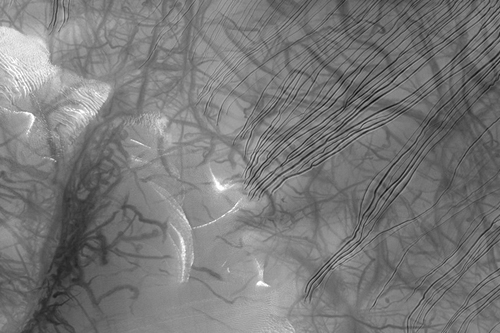The High Resolution Imaging Science Experiment at the University of Arizona is hosting some gigantic images snapped (or rather scanned) by the Mars Reconnaissance Orbiter (MRO). The full version of the image shown below is 31,850 x 77,994 pixels! Each pixel represents 30 cm on the Martian surface.

It wasn't until Photoshop CS (8.0) that the program could even accept images bigger than 32,767 on a side, and few available file format modules can import such images, but j2k 2.01 can. Granted, doing so can take quite a while between the decompression process and all the virtual memory swapping Photoshop needs to do to.
A more efficient way to browse their JPEG 2000 images is by clicking on a link that brings up the Java-based IAS Viewer, which dynamically loads just the part of the image you're viewing at just the resolution you need, taking advantage of one of the key features in JPEG 2000. They also have a sweet Flash-based app to do the same. This reminds me of a personal feature wish for j2k to allow the user to reduce resolution when importing big files into Photoshop.
2 comments:
Don't know if this is the right place to do it - but I just wanted to say THANKS! - for the jpeg2000 plugin for photoshop, which has turned out to be a lifesaver, as I am currently archivingseveral thousand historical b&w 35 mm negatives. At the resolution I am scanning at, the tiff files are coming in at 130 mb each! and though they compress down ok to jpegs, I jut desperately need to hang on to the 16 bits of grey, since some of them are hugely under, or over-exposed and will need major work if they are ever used.
The JPEG 2000 plugin does just the job - allowing me to save them as 16 bit files, at about 5 -7 megs each with no discernable loss of quality - fantastic! Thanks for your wonderful work!
I am using the windows version, and the only thing that isn't perfect, is that the images acquire a noticeable darkening when saved, and require application of a curve to correct them again before i can work with them. Is this just a windows thing do you think? I will have to try it on a mac and see...
Andy
Thanks for the comments, Andy. I'm surprised to hear about the unexpected darkening on Windows. One possibility is that JPEG 2000 demands color management. If you aren't using any color management in Photoshop, that could explain the discrepancy between what you see when saving vs. what you see when opening.
Email me a file and I'll investigate.
Brendan
Post a Comment